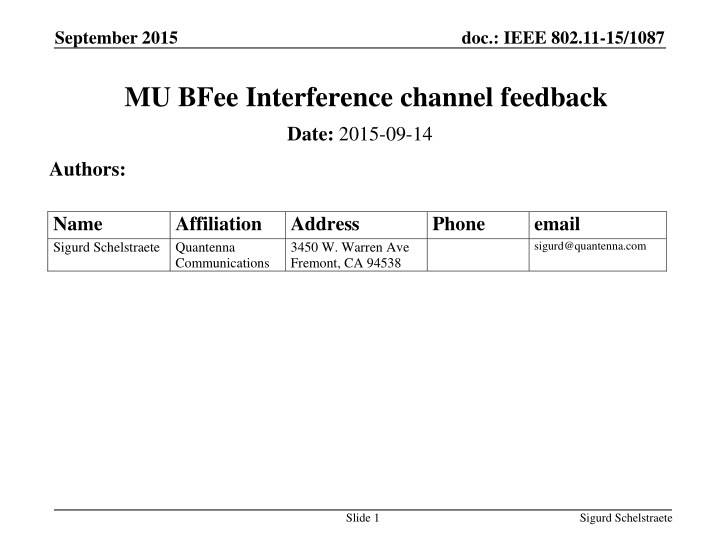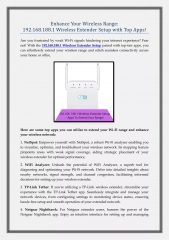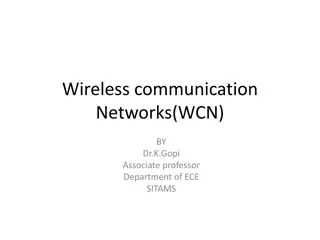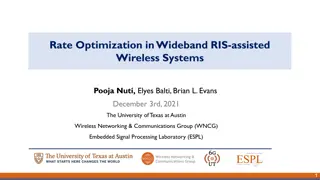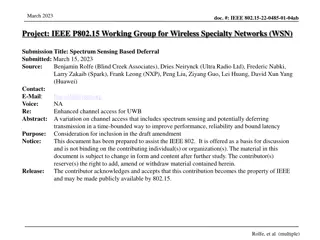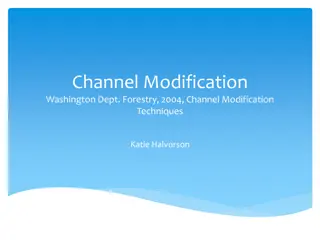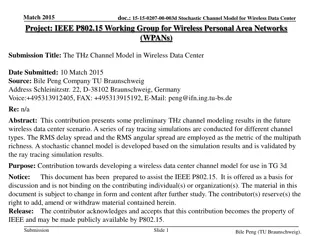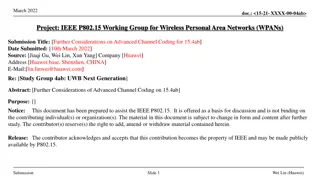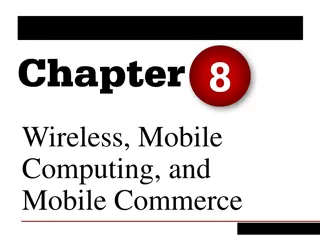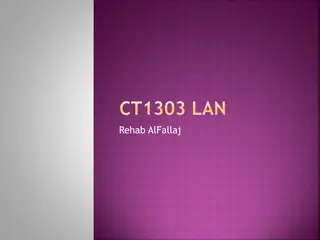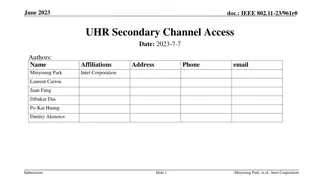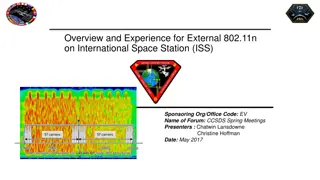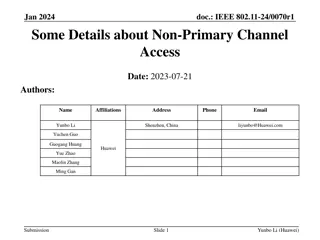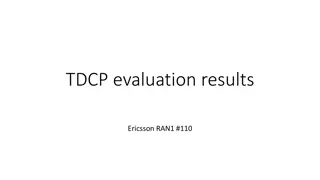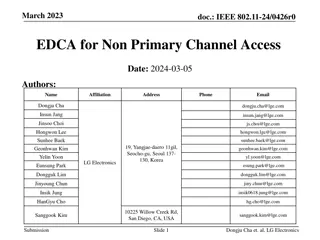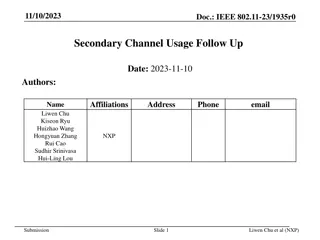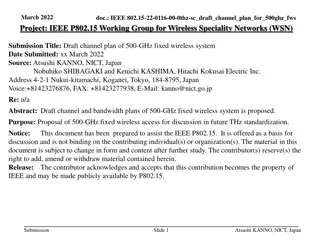Managing Channel Information for Wireless Communication Systems
This document from September 2015 discusses issues related to updating channel information in wireless communication systems, focusing on MU-MIMO and TxBF precoding techniques. It explains the challenges of channel aging, the importance of refreshing channel information, and the impact of different sounding frequencies on system performance. Additionally, it explores the effects of changing channels on SINR and compares SINR calculations between outdated and up-to-date channel information scenarios.
Download Presentation

Please find below an Image/Link to download the presentation.
The content on the website is provided AS IS for your information and personal use only. It may not be sold, licensed, or shared on other websites without obtaining consent from the author.If you encounter any issues during the download, it is possible that the publisher has removed the file from their server.
You are allowed to download the files provided on this website for personal or commercial use, subject to the condition that they are used lawfully. All files are the property of their respective owners.
The content on the website is provided AS IS for your information and personal use only. It may not be sold, licensed, or shared on other websites without obtaining consent from the author.
E N D
Presentation Transcript
September 2015 doc.: IEEE 802.11-15/1087 MU BFee Interference channel feedback Date: 2015-09-14 Authors: Name Sigurd Schelstraete Quantenna Affiliation Address 3450 W. Warren Ave Fremont, CA 94538 Phone email sigurd@quantenna.com Communications Slide 1 Sigurd Schelstraete
September 2015 doc.: IEEE 802.11-15/1087 Problem statement MU-MIMO and TxBF precoding are based on channel information obtained during sounding Snapshot in time The natural variability of the wireless channel causes the channel information and hence the precoding matrices to age Loss of BF gain over time in changing channel Loss of interference cancellation over time in changing channel Channel information and precoding matrices need to be refreshed at an appropriate rate to keep up with the changes Slide 2 Sigurd Schelstraete
September 2015 doc.: IEEE 802.11-15/1087 Sounding Updating channel information implies overhead Protocol overhead from sounding and sounding feedback Resources should be managed carefully Excessive sounding wastes channel capacity without benefit Too few soundings degrade performance, especially for MU- MIMO MU-MIMO needs more frequent updates than BF Depends on environment and can change over time How to find the right sounding frequency? Too frequent sounding increases overhead Too infrequent sounding increases interference Slide 3 Sigurd Schelstraete
September 2015 doc.: IEEE 802.11-15/1087 Illustration: Effect of changing channel on SINR A single-tone matrix model for changing channel Choose two independent channel matrix realizations Perform precoding based on the initial channel values Morph the channel from its initial value to the other realization E.g.: 1x4 channel (H1, H2, H3, H4) Slide 4 Sigurd Schelstraete
September 2015 doc.: IEEE 802.11-15/1087 SINR calculation For channels ??, ? = 1, ,?? and precoding matrices ??, ? = 1, ,??: Evaluate SINR: ?? ?????= ??+ ?0 With: +?? +???? ??= ????? ?? +?? +???? ??= ????? ?? ? ? We compare to an ideal reference where precoding matrices are up to date with latest channel information Equivalent to sounding right before the transmission of the packet Slide 5 Sigurd Schelstraete
September 2015 doc.: IEEE 802.11-15/1087 1. No re-sounding 4x4 AP, three 1x1 users Dramatic loss in SINR over time Slide 6 Sigurd Schelstraete
September 2015 doc.: IEEE 802.11-15/1087 2. Re-sounding with fixed interval 100 msec sounding interval SINR restored after each sounding, gradually degrading between soundings Slide 7 Sigurd Schelstraete
September 2015 doc.: IEEE 802.11-15/1087 3. Re-sounding based on max SINR degradation Sounding triggered by 3dB SINR degradation Frequent resounding needed to limit SINR degradation within desired bounds Slide 8 Sigurd Schelstraete
September 2015 doc.: IEEE 802.11-15/1087 How to optimize sounding overhead? Sounding frequency is important to maintain MU interference cancellation Should be adaptive depending on channel behavior Rate adaptation alone can not distinguish between effects of interference and other effects The AP (or BFer in general) can implement adaptive behavior if it is provided with some information about effectiveness of its current precoding Slide 9 Sigurd Schelstraete
September 2015 doc.: IEEE 802.11-15/1087 What information can the STA provide? Using the MU preamble, the STA (MU BFee) can estimate the channel between its Rx antennas and every stream in the MU packet Including streams for other users ( interference channels ) With ZF precoding, interference channels are expected to be zero However, this will change as the precoding matrices age The value of the interference channels is a measure of the effective quality of the precoding used at the transmitter Slide 10 Sigurd Schelstraete
September 2015 Illustration: MU channel estimation in changing channel doc.: IEEE 802.11-15/1087 MU to two STAs NSTS,total = 4 NSTS = (2,2) Initially, channel for two streams is just noise As channel changes, loss of precoding is seen on the interference channels Channel from all four streams to first antenna
September 2015 doc.: IEEE 802.11-15/1087 What information can the STA provide? The STA has direct information that can be used by the BFer to perform more optimal sounding But it s not sharing The receiver ? directly sees ????: Feeding back information about the interference channels gives the BFer a direct view of the effectiveness of it current MU precoding Slide 12 Sigurd Schelstraete
September 2015 doc.: IEEE 802.11-15/1087 Proposal Proposal: feed back some measure of ???? (for ? ?) from receiver ? to the MU BFer Information can take many forms: Full information Magnitude Relative magnitude (signal to interference) Threshold exceeded indication MU BFer can use that information to guide sounding decisions Precise algorithm outside the scope of the standard Slide 13 Sigurd Schelstraete
September 2015 doc.: IEEE 802.11-15/1087 Keep overhead low Information can be quantized in low # bits We expect small values Information can be provided on a subset of tones or as an average We don t expect huge tone-to-tone variations Information can possibly be piggy-backed on the regular ACK frame Data frame will be followed by ACK anyway (mostly ) This avoids separate exchange Slide 14 Sigurd Schelstraete
September 2015 doc.: IEEE 802.11-15/1087 Summary MU needs frequent sounding to maintain precoding Optimal sounding frequency is function of environment Sounding implies overhead STAs (MU BFees) have information of the effectiveness of precoding From observing the interference channels Feedback from the MU BFee allows BFer to make more informed decision on sounding Reducing protocol sounding overhead Let s provide a mechanism to enable interference channel measurement from BFee to BFer Slide 15 Sigurd Schelstraete
September 2015 doc.: IEEE 802.11-15/1087 Straw Poll Do you agree to add the following to the IEEE 802.11 TGax Specification Framework? 11ax shall define a mechanism to enable MU BFees to provide the MU BFer with feedback information on the interference channel estimates determined at the receiver Note: interference channel estimate means the channel estimate for a stream that is present in an MU transmission but that is not intended for the MU BFee itself. Slide 16 Sigurd Schelstraete
